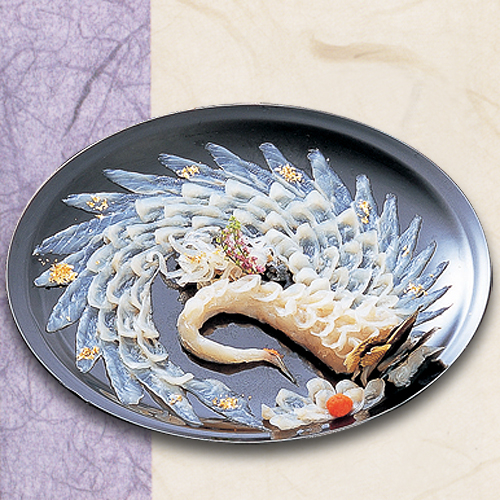
to the soup stock made with kelp and blowfish. Add blowfish meat, white vegetables, raw shiitake mushrooms, white onions, garland chrysanthemum, tofu, scraps, etc. The umami of blowfish is condensed in the juice, and you can enjoy the deep taste to the end, so it is a popular way of eating that is recommended by locals. In Yamaguchi Prefecture, a hot pot made by cooking blowfish meat and vegetables in kelp soup stock is called “tetchiri”. Chopped scallions and grated Japanese radish are the standard condiments, and if you wrap the green onions in blowfish and eat them, the taste will be even better. It is recommended to eat with ponzu instead of soy sauce. The whole meat of the fish is so beautiful and it has a light taste unique to white fish and is characterized by a crunchy texture. Fugu sashimi is, as the name suggests, blowfish sashimi. If you want to enjoy the original taste of blowfish, “Fugu sashimi” is the most recommended dish. The pufferfish is directly transported by fishing boat from the pelagic oceans of the East China Sea, the Yellow Sea, and the Sea of Japan to the Shimonoseki area where pufferfish are accumulated, and from nearby waters such as the Seto Inland Sea. The distribution channel of blowfish is complicated. However, it was not Shimonoseki that devised this longline fishing, but a fisherman who lived in Sukumo Island, Shunan City, Yamaguchi Prefecture. This amount method is called the longline fishing method, but in fact, the inventor of this longline fishing method was also a resident of Yamaguchi Prefecture.
#SASHIMI FUGU HOW TO#
HOW TO MADE? The Processįuku or Fugu fishing uses a single fishing line called longline fishing, which has many needles. After that, from the Taisho era to the early Showa era, the Fugu food culture prospered greatly in Shimonoseki due to various geographical and cultural factors, and as this was transmitted to Tokyo, the fame of “Fugu wa Shimonoseki” spread and eventually became established.
#SASHIMI FUGU LICENSE#
The ban on blowfish food was lifted only in Yamaguchi Prefecture.ĭue to this event, Shunhoro became the first official license of a blowfish restaurant, and Shimonoseki made a start to make its name known throughout the country as the home of blowfish.

Under such circumstances, Hirobumi Ito, who ate the blowfish produced by the proprietress, praised its deliciousness and ordered the then governor of Yamaguchi Prefecture, Taro Hara, to forbid such delicious food in 1890.

The ban was lifted when the proprietress “Michi” was prepared to take care of her and served Fugu as a hospitality dish to Hirobumi Ito. Fugu food remained banned.Īt the end of the 20th year of the Meiji era, when the first Prime Minister Ito Hirobumi stayed at the long-established Japanese-style inn “Shunpanro” in Shimonoseki, which is located on a hill overlooking the Kanmon Straits, the sea was so big that there was no fish. During the Azuchi-Momoyama period, when Toyotomi Hideyoshi sent troops to the Korean Peninsula, he set up a camp at Nagoya Castle in Kyushu (currently Karatsu City, Saga Prefecture), but before sending the troops to the war, many of the gathered samurai died when they ate blowfish, so the “Kawabuta Eating Ban Ordinance” was issued, and even after entering the Meiji era after the Edo period. Fugu bones have also been excavated from the Yayoi period ruins in Shimonoseki and were believed to be 2,000 to 2,500 years old.Īs the times went down from this era when seafood was actively eaten, the development of agricultural culture made it possible to obtain stable agricultural products which reduced the dependence on these foods and made the blowfish stand out. It was believed that the blowfish had already been eaten by those times. It was said that the bones of the pufferfish family have been found along with much other fish including shellfish from the remains of the Jomon period, which is said to be 6,000 years ago. The relationship between the Japanese and blowfish is considered to be ancient.

In Shimonoseki City, Yamaguchi Prefecture, which boasts the largest amount of blowfish in Japan, you can eat high-quality blowfish that are plump and firm. The origin of Fuku is famous for having auspiciousness as good fortune, but it is also said that it is to avoid unlucky words such as “impaired” and “unlucky” associated with the sound of ” Fugu “. There are various theories involving the originality of the name Fuku. Fuku / Fugu is a Japanese word for pufferfish and the dish is prepared from it in an integrated area of Yamaguchi Prefecture Shimonoseki.


 0 kommentar(er)
0 kommentar(er)
